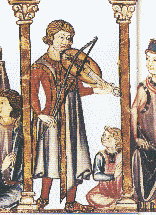
File:Vielle.jpg
| |
This is a file from the Wikimedia Commons. Information from its description page there is shown below.
Commons is a freely licensed media file repository. You can help. |
Summary
| Description | Someone playing the vielle. Cantigas de Santa Maria, about 1300. German specialists answer about the origin: "Was das Bild angeht: es stammt aus einer der Handschriften der Cantigas de Santa Maria. Ich müßte genau nachschlagen aus welcher und wie die genau datiert wird... (entweder spätes 13. Jh. oder frühes 14. Jh. - mit Gerard David (15. Jh.) hat das so überhaupt gar nix zutun). OK, ich habe zwar die Faksimiles von 2 der Hauptcodices, aber nicht vom 3., der am reichsten illuminiert ist (das Faksimile kosten diverse Tausend Euro) - ohne jetzt in die Musikwissenschaft Basel zu gehen und dort den Mikrofilm durchzusehen oder zu schauen ob die das Fakimile haben, könnte ich jetzt nur indirekt erschließen: aufgrund stilistischer Vergleiche, würde ich mit 95%iger Sicherheit sagen: es handelt sich um eine Abbildung aus dem Codex E2, auch Codex T genannt - der hat über 1200 Miniaturen und ist der am reichsten geschmückte der Cantiga Codices. Datiert wird er auf das Ende des 13. Jh.: San Lorenzo de El Escorial, Biblioteca del Real Monasterio, T.I.1 (also known as T.j.1) [e; E²; T]. 256 parchment leaves, 49 × 33 cm. Modern arabic foliation in pencil; songs numbered with illuminated Roman numerals on both leaves, top centre. Layout: normally 2 columns, 44 lines or 11 staves a page; red and blue illuminated capitals; each song headed in red. Illuminations: 1264 magnificent miniatures, normally grouped by 6 (1 full page corresponding to a song) or 12 (2 full pages, singling out the fifth song in each group of 10). Scribes: no detailed study; seemingly uniform French gothic hand. Notation: proto-mensural, based on, but not identical to French pre-Franconian practice (Ferreira, 1987, 1993). Date: ?1280–84 (Ferreira, 1994) Contents: on f.4, after the surviving folios of the index, a fragmentary cantiga without music forms an ‘appendix’; on f.4v the main collection begins, with 194 cantigas (including 3 fragmentary, of which 2 without music, and 1 more with empty staves). This is the first volume of a set of 2; the second, incomplete volume, containing 104 songs with empty staves, is now in Florence, Biblioteca Nazionale Centrale, B.R.20 [F]. Facs.: El ‘Códice Rico’ de las Cantigas de Alfonso el Sabio: Ms. T.I.1 de la Biblioteca de El Escorial (Madrid, 1979) Also: ich konnte das Bild direkt nicht finden - dazu müßte man das Faksimile durchsehen und nach diesem Ausschnitt suchen - aber stilistisch ist ziemlich eindeutig, daß es eine Cantiga-Abbildung sein muß (und selbst wenn nicht, dann ist es ziemlich eindeutig 13. Jh., bzw. um 1300, keinesfalls 15. Jh.) - ich habe die Art der Abbildung mit anderen aus dem T-Codex verglichen und sie scheint aus diesem oben genannten Codex zu kommen (u.a. habe ich dort in anderen Abbildungen, die ich habe, die Säulenkapitelle wiedergefunden)." |
| Date | |
| Source | http://en.wikipedia.org/wiki/Image:Vielle.jpg |
| Author |
This file is lacking author information.
|
Licensing
 |
Permission is granted to copy, distribute and/or modify this document under the terms of the GNU Free Documentation License, Version 1.2 or any later version published by the Free Software Foundation; with no Invariant Sections, no Front-Cover Texts, and no Back-Cover Texts. Subject to disclaimers. www.gnu.org/copyleft/fdl.htmlGFDLGNU Free Documentation Licensetruetrue |
| This file is licensed under the Creative Commons Attribution-Share Alike 3.0 Unported license. Subject to disclaimers. | ||
|
||
| This licensing tag was added to this file as part of the GFDL licensing update.http://creativecommons.org/licenses/by-sa/3.0/CC-BY-SA-3.0Creative Commons Attribution-Share Alike 3.0 truetrue |
The official position taken by the Wikimedia Foundation is that "faithful reproductions of two-dimensional public domain works of art are public domain, and that claims to the contrary represent an assault on the very concept of a public domain". For details, see Commons:When to use the PD-Art tag. {{ PD-Art}} template without parameter: please specify why the underlying work is public domain in both the source country and the United States
(Usage: {{PD-Art|1=|deathyear=|country=|date=}}, where parameter #1 can be PD-old-auto, PD-old-auto-1923, PD-old-100 or similar) |
|||||
File usage
The best way to learn
SOS Childrens Villages has brought Wikipedia to the classroom. In 133 nations around the world, SOS Children's Villages works to bring better education and healthcare to families in desperate need of support. Why not try to find out more about sponsoring a child?


